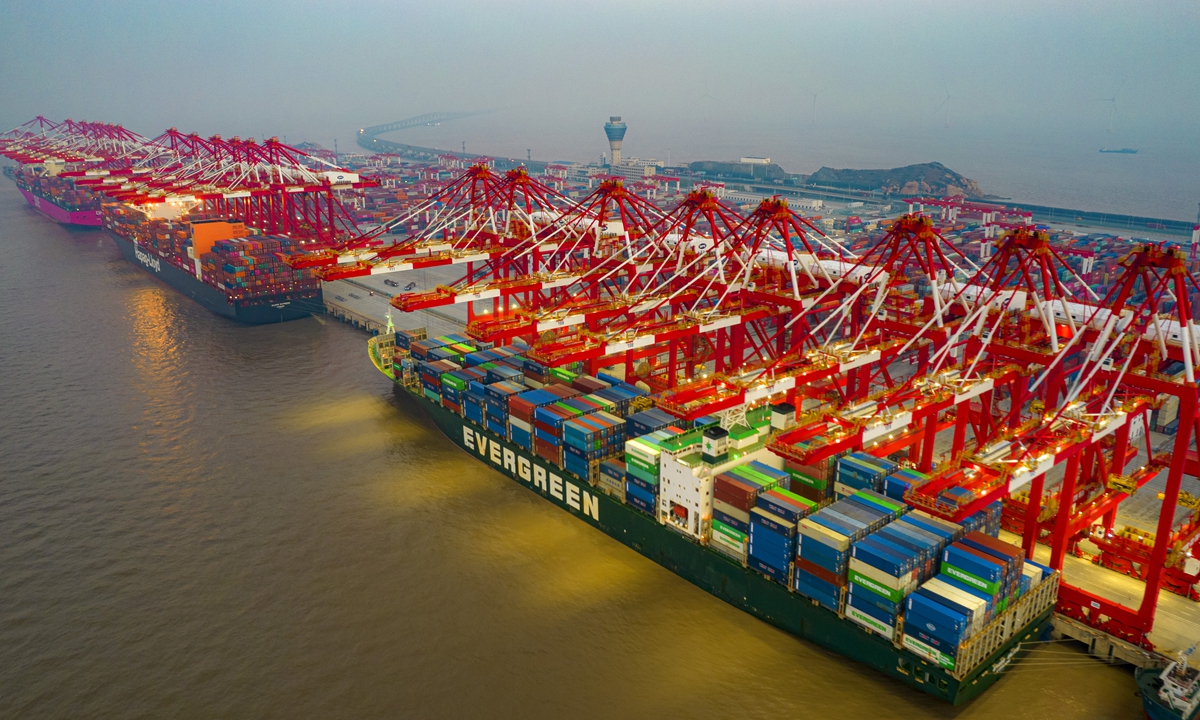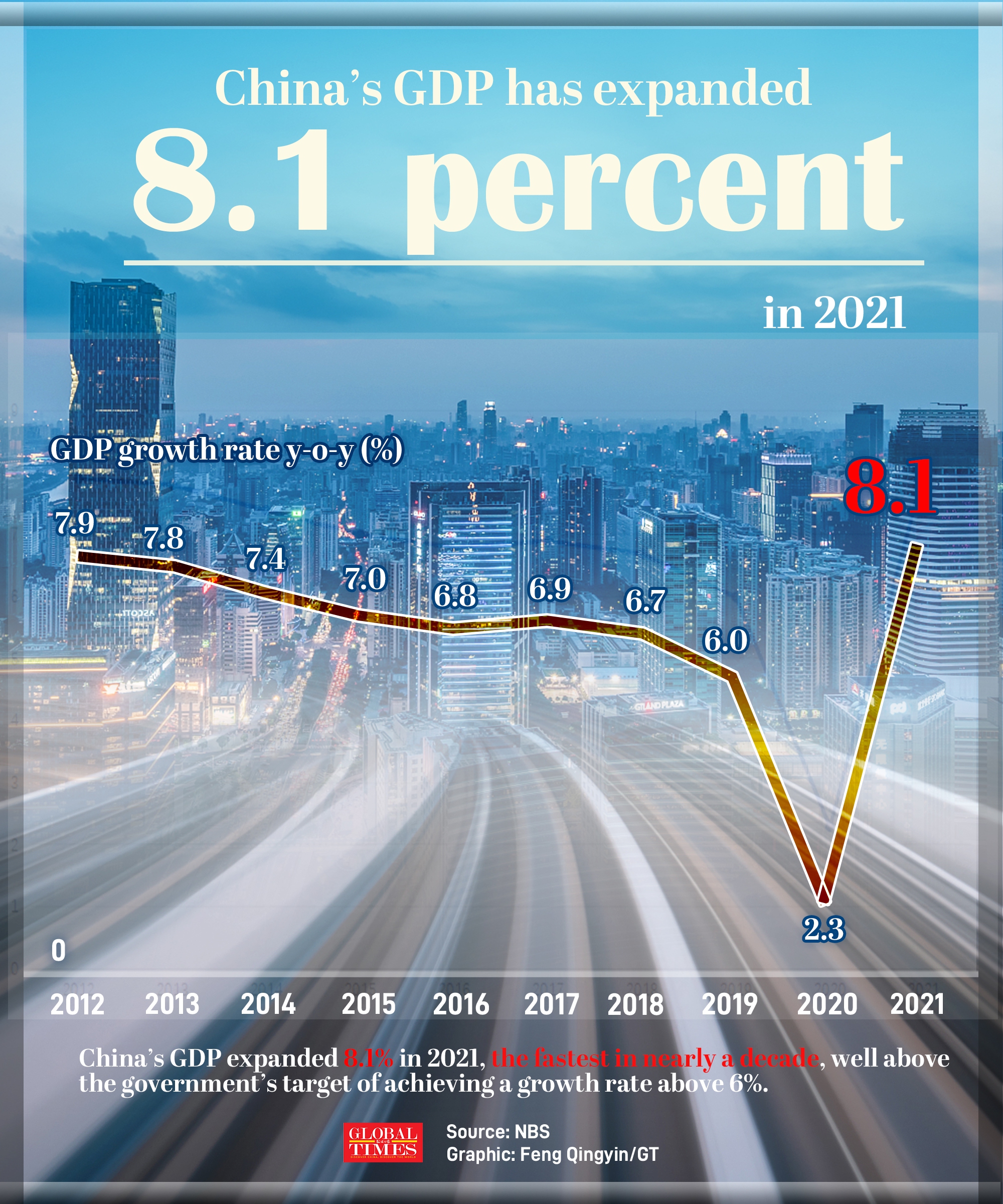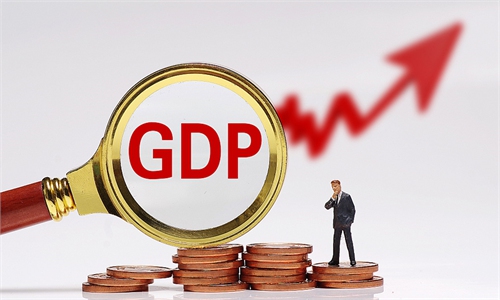China’s GDP grows 8.1% in 2021, fastest in 10 years, spurring confidence despite challenges ahead
Stellar performance boost confidence, but challenges emerge

Container vessels berth at the Port of Yangshan to clear cargo around the clock in Shanghai on January 2, 2022. In 2021, the Port of Shanghai handled over 47 million standard containers, ranking first among the world's ports for the 12th consecutive year. Photo: VCG
China on Monday posted an 8.1 percent GDP growth in 2021, defying market expectations and further cementing the world's second-largest economy's leading position in the global economy's recovery from the still raging COVID-19 pandemic, as major growth drivers, particularly exports, saw remarkable improvements in the face of mounting global challenges.
However, a significantly slower GDP growth of 4 percent in the last quarter of 2021, the weakest since the second quarter of 2020, also offered sobering reminders of the growing downward pressure on the Chinese economy, including from shrinking demand, supply chain disruptions and weakening expectations, in addition to risks of the spread of the Omicron variant.
Chinese economists noted that China is still positioned to tackle those challenges, given the solid foundation of the Chinese economy and sufficient fiscal and monetary tools at the disposal of policymakers, who are already moving to boost consumption, liquidity and other issues. Despite risks, some economists are expecting 5.5 percent growth in 2022.
China's GDP expanded 8.1 percent in 2021, growing the fastest in nearly a decade and landing well above the government's annual target of achieving a growth rate above 6 percent.
The robust expansion, which beats market expectations and eclipses most of the other major economies in the past two years, spells out a steady economic recovery path - building upon the country's zero-tolerance epidemic strategy that Beijing has been relying on despite criticism from the West and headwinds throughout the year, which ranged from sporadic coronavirus outbreaks, woes in the property sector, bulk commodity price hikes, to a power crunch.
The country's total GDP in 2021 reached 114.37 trillion yuan ($18 trillion), according to data released by the National Bureau of Statistics (NBS) on Monday.
This represents an increase of $2 trillion compared to 2020, or roughly the equivalent of Italy's GDP in 2020 based on Global Times calculations.

GDP
Rising trend
In the fourth quarter of 2021, China's GDP grew at 4 percent, beating estimates that growth in the quarter, marred by epidemic flare-ups, rising commodity prices and electricity shortages, would fall below that mark.
Despite being the slowest growing quarter for the year, there was quarter-to-quarter growth and the growth was achieved on top of a 6.5 percent growth in the fourth quarter of 2020, analysts said.
China's fourth quarter GDP data is also likely to be better than the US' numerically, analysts pointed out, predicting US GDP from October to December to be no more than 3 percent due to runaway inflation that rose to 7 percent in December, the fastest since 1982, that offset much of the growth.
In comparison, European manufacturing and exports powerhouse Germany's economy shrank by nearly 1 percent in the fourth quarter.
Also on Monday, the People's Bank of China, China's central bank, lowered medium-term lending facility interest rates by 10 basis points, the first time since April 2020 and about one month after it cut the reserve requirement ratio, a move which experts interpreted as aiming to direct domestic banks to lower market interest rates amid downward economic pressure.
With issues ranging from a power crunch, supply chain issues and tightening credit in the property sector weighing on the economy being addressed during the fourth quarter, analysts are predicting the Chinese economy could be off to a head start in 2022, with a possible 5.5 percent annual expansion for the whole year.
Cao Heping, an economist at Peking University, told the Global Times on Monday that he believes China has three favorable conditions to prop up growth in 2022 - China has a full-blown digital economy; its central government wields a powerful fiscal tool and holds effective international policy, such as the Belt and Road Initiative which stood to test during 2021.
China also stands to benefit from the Regional Comprehensive Economic Partnership (RCEP) pact, which has created the world's largest free trade bloc. It is estimated the pact will lift regional GDP by 0.86 percent by 2035, a report by the Chinese Academy of International Trade and Economic Cooperation in November.
Nevertheless, Cao said a growth of over 8 percent is still a feat with the help of some luck, with the economy facing continuous disruptions from new virus mutations and the roadblocks set up by the US in the global market.
In 2020, China was the only major economy in the world to eke out an expansion, with a GDP growth of 2.3 percent. Taking out the base effect and translating into two-year terms for an objective evaluation, China's average GDP growth was 5.1 percent from 2020 to 2021, arguably one of the fastest growths among major economies, analysts said.
China's 8.1 percent GDP growth in 2021 is also in a leading position among major global economies, and it is estimated China's share of the global economy exceeded 18 percent in 2021, according to NBS.
Some Chinese economists estimated that China's economic increment has contributed an overwhelming 50 percent to the world, highlighting China's role as the anchor and stabilizer of the global economy.
Cao predicted a 5.5 percent growth in 2022 provided that the pandemic does not inflict much downward pressure in the new year.
Stable growth for 2022
While the Western media have been hyping how China's dynamic zero-tolerance COVID strategy inflicted tremendous damage on the world's second-largest economy, analysts debunked these claims by pointing out that it is the strategy that cost less to ensure that the world's largest factory recovered faster, kept roaring and supplied the world.
In 2021, China's GDP per capita was around $12,551, according to the NBS, nearing that of a "high-income country" as defined by the World Bank and overtaking the global average GDP per capita.
2022 marks the second year of the country's 14th Five-Year Plan (2021-25), as the country faces the so-called triple pressure from shrinking demand, supply shocks and weakening expectations.
Yao Jingyuan, special researcher of the Counselors' Office of the State Council, told the Global Times on Monday that China has the environment, method and experience to blunt the risks posed by the triple pressure.
Yao predicted that China would set an annual GDP goal for 2022 at above 5 percent, a range that could ensure the economy maintains its reasonable speed but also coordinates with a set of other broad agendas of the country ranging from the 14th Five-Year Plan and long-range objectives through 2035.
At the Chinese economy's current base, one percentage point of GDP growth generates 2 million jobs, a 5-percent growth for 2022 diffuses pressure from the job market, and ensures corporate profits and employee income. It is also not too fast as to undermine the pursuit of high-quality growth, Yao said.
Ning Jizhe, head of the NBS, told a State Council Information Office press conference on Monday that the country has the confidence and capabilities to ensure sustained and sound economic development going forward despite rising challenges, pointing to various emerging growth points within the economy, including growing fixed-asset investment.
With the acceleration of special bond issuance and the start of construction of a large number of major projects, the growth of fixed-asset investment, one of China's three drivers of economic growth, is set to pick up this year, Ning said.
Yao said to prop up investment, the Chinese government could unleash the 102 mega projects earmarked for the 14th Five-Year Plan period slightly ahead of schedule, with more projects landing in 2022-23 to generate more concrete workload and give the economy a necessary push.
"Those mega projects have been carefully studied and deliberated and there is no risk of bubbles. This boost from the infrastructure sector alone could stabilize domestic demand," Yao said, noting that China has done such upfront move before and has the required experience.
Confidence becomes one of the most watched indicators under the current situation, as some overseas media reports claimed that getting Chinese people to spend money would be one of China's biggest challenges for 2022.
To maintain and shore up confidence, Yao suggested that the country center its monetary policy and fiscal policy on companies and entrepreneurs, with the former to reduce borrowing costs and the latter on tax and fee cuts. The attitude held by companies lies at the heart of shoring up confidence campaign given their role as the primary market participants.



